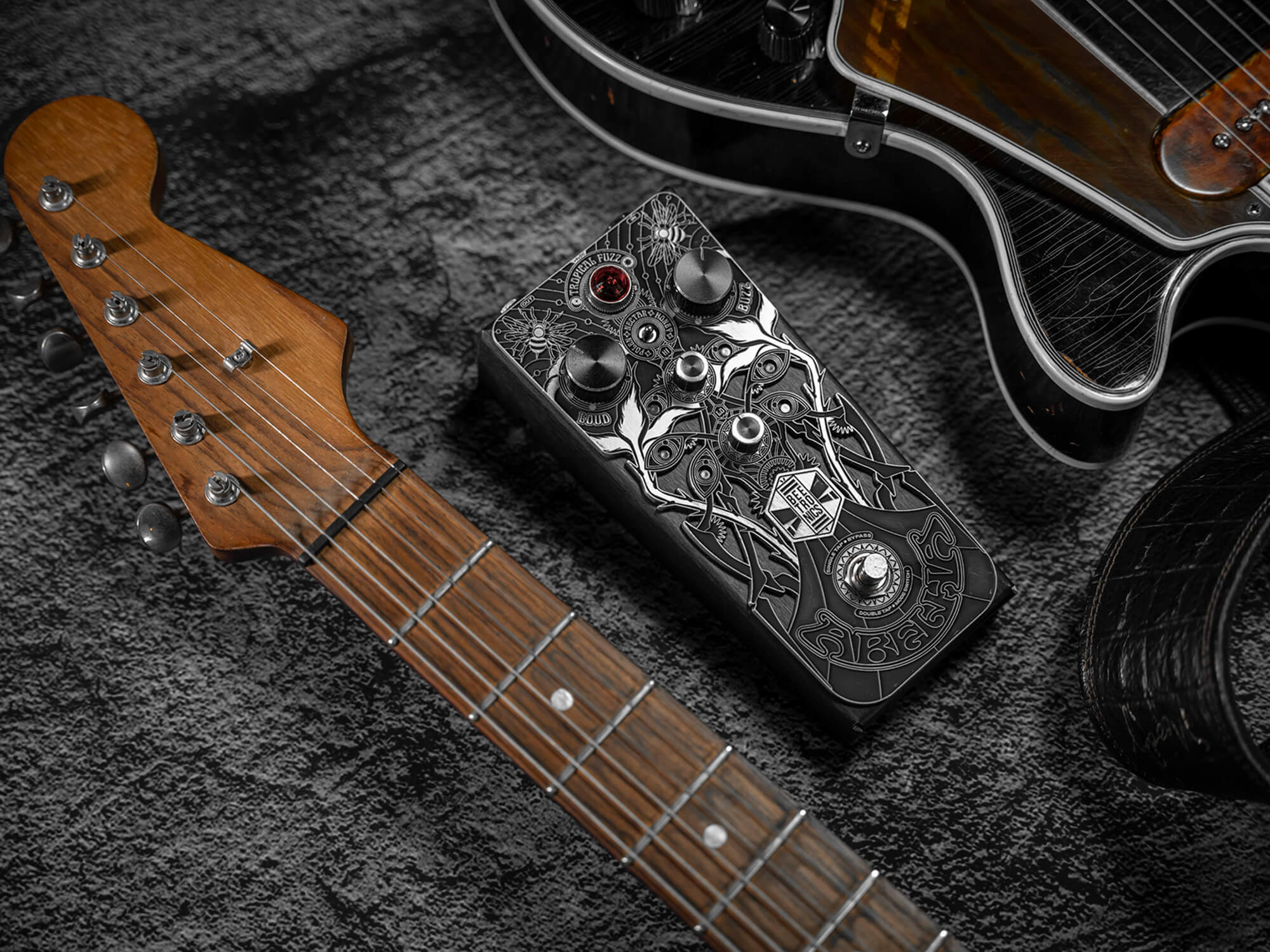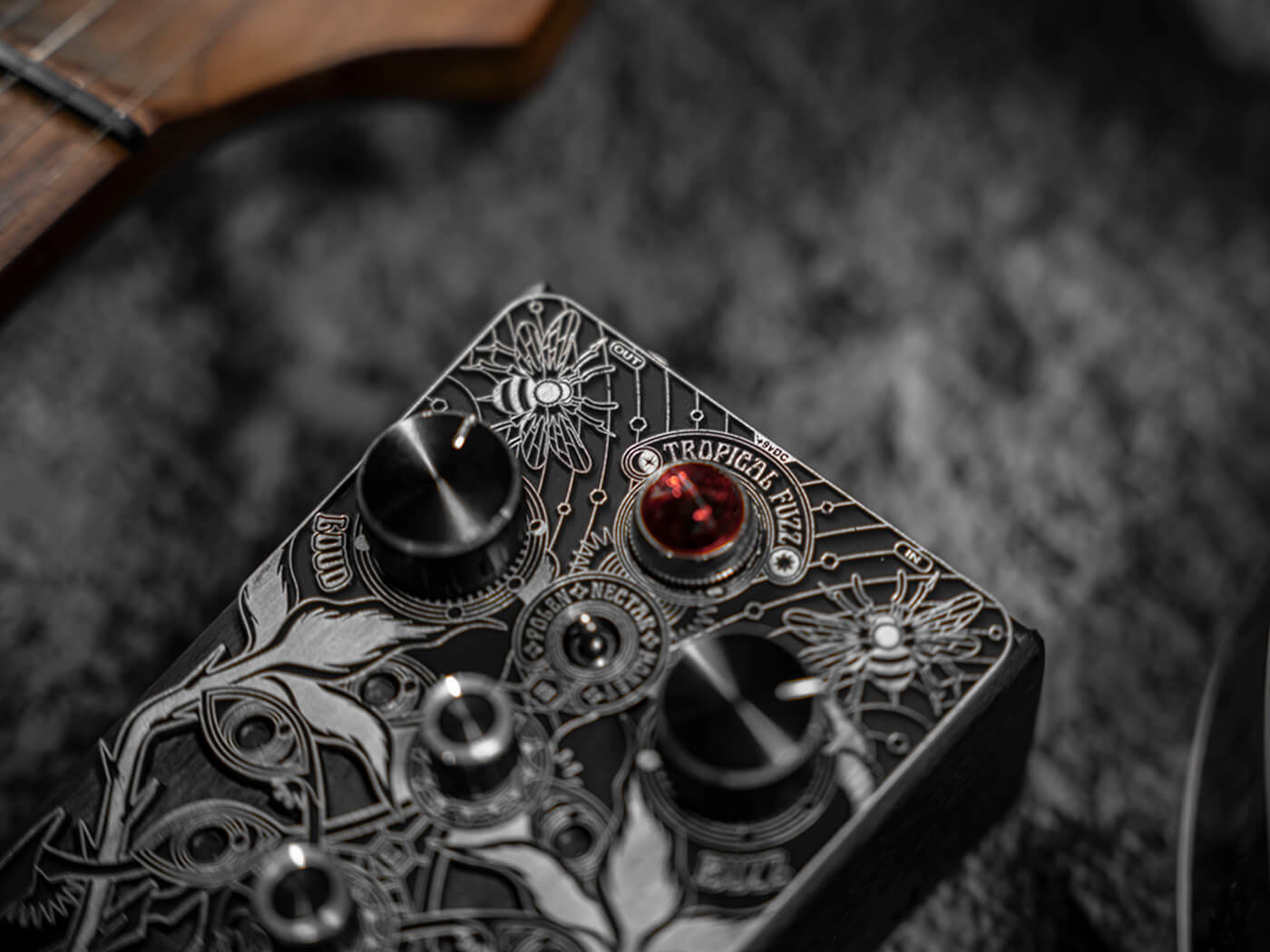Related Tags
Beetronics Abelha review: buzzy fun or a wasp in a jar?
Beetronics’ latest fuzz is centred around some truly trebly tones. Does it make for psychedelic fun, or will you be left feeling stung?

Beetronics Abelha
Review Overview
Our rating
8
Our verdict
$289/£239, beetronicsfx.com
There’s a good argument to be made that Beetronics is the most innovative pedal brand out there. Obviously, their aesthetics and sheer commitment to the bee bit is commendable, but the out-there looks are backed up by even more out-there circuits. But making out-there pedals means that, inevitably, they won’t be for everyone. And thus we come to the Abelha, a fuzz pedal that’s so love-it-or-hate-it, it might as well be made out of pure Marmite.
The Abelha is a multi-mode fuzz pedal inspired by the guitar sounds of Tropicália – a Brazilian art movement that, among a broader context of political pop-art, also spawned a whole lot of awesome psychedelic music across the 1960s. Being a Beetronics pedal, it’s of course bloody gorgeous, with an intricate 3D faceplate and six colour-changing LEDs alongside its main bypass LED. It has a rather unique voicing which we’ll explore later, but keep in mind that Abelha means Wasp in Portuguese – that should give you some clue as to the sonic profile of the thing.
The way the modes work is interesting. There are three main fuzz voices: Pollen, Nectar and Honey – and the pedal as a whole can either be in a standard mode or Tropical mode, with a drastic shift in sound between the two. The fuzz voice is chosen by a mini-toggle at the top of the pedal, while Tropical mode is engaged with a double-tap of the main footswitch. You can also just hold the footswitch down for a momentary shift between modes.
Knobs consist of Loud (volume) and Buzz (gain), as well as a two-band EQ. So, relatively simple for a Beetronics pedal on the face of it, but without spoiling anything there’s of course more to this buzzbox than meets the eye. Let’s hive in. Dive. Let’s dive in.

How does the Beetronics Abelha sound?
Starting in normal mode, in the central Nectar voicing and with every knob at noon, first impressions of the Abelha are good. It is decidedly vintage, with a bit of rasp in the mix, but things are, for now, pretty smooth, with a nice and present midrange. The sweep of the Buzz pot isn’t anything to write home about, though: it goes from quite fuzzy to very fuzzy, and there’s no Fuzz Face-style volume-knob cleanup here. The two-band EQ is as handy as you’d expect – while the impact of the controls isn’t huge, they do let me easily sit the Abelha within my full signal chain.
Next I flip over to the Honey mode, which is (appropriately) a little bit sweeter. Beetronics does call it a drive, but to my ears it’s still got a very fuzzy character. Really, it reminds me a little of a Germanium Fuzz Face, bar the cleanup: there’s a good thunk on the pick attack as well as a fairly broad frequency response. And despite its obvious fuzz character, there’s more clarity than you might expect: even cowboy chords sound big and full rather than crowded and messy.
Heading the other way to Pollen, and I’m greeted with a much more dramatic shift in sound – while Nectar and Honey are crunchy enough, here we’ve got a veritable square-wave synth sound: gated, spitty, bassy. While anything with harmonic complexity gets chewed up in the chaos, leads are incredibly enjoyable and power-chords are huge and crunchy. It’s a great sound, and that two-band EQ shines again in taming some of the more aggressive bass frequencies.

Tropical mode
Things have remained fairly ‘normal’ so far, especially for a Beetronics pedal. Three good – but maybe unremarkable – fuzz sounds. The brand’s signature weirdness is yet to rear its head. And then I engage that Tropical mode with a double-tap of the footswitch. And, well, as the other members of the Hymenoptera order said in the mid-Triassic period: “here come the wasps”.
Tropical mode, indicated by a change in colour of those six LEDs, re-voices all three fuzz modes through an aggressive high-pass filter, meaning very little low-end and loads of raspy high-end. Charitably, it’s… kind of a horrible sound. Which is, as far as I can tell, the point. But it’s worth noting that on this very expensive fuzz pedal, three of the six sounds available are akin to trying to remove your cochlea with a pair of knitting needles.
But that’s in isolation: as part of a full mix, the complete commitment to trebly screech does evoke the raspy, filtered lead lines of Brazilian psych-rock legends like Os Mutantes. I mean, listen to the guitar lines on A Minha Menina – you’d get a bassier sound through a tin can on a string. But, as part of the song, it totally makes sense.
Similarly, having gotten over the sonic shock of the sheer thinness of the sounds, they do have their place on the pedal. This is one of the rare instances where I found momentary switching to be musically useful, rather than just a gimmick. Quickly engaging Tropical mode to stab through a mix and emphasise a riff makes much more sense, at least to me, than leaving it on all the time.
Really, the important takeaway here is that your mileage may vary. You may be reading this and going “raspy, filtered and overly trebly? That sounds perfect for me!” – and if so, godspeed to you and your cochleas. But, if you like a big, full, roaring fuzz tone, keep in mind you’ll probably only like half of this pedal.
And that’s the difficult thing about evaluating the Abelha: what makes it stand out is also what makes it hard to recommend. Has Beetronics mistakenly mangled a perfectly fine fuzz in the name of sonic exploration, or has it offered something genuinely new in a market crowded with a million soundalikey pedals? I can see both sides. On the one hand, I have to applaud Beetronics for the sheer boldness of the Abelha’s USP: even if I personally wouldn’t stick it on my pedalboard, the Abelha aims to capture a very unique sound, and completely succeeds in doing so. That is genuinely worthwhile, especially when so many fuzzes are just iterating on old circuits. On the other hand: ow, my ears.
Quirks to consider
Because of its unique switching, the pedal turns off about half a second after tapping the footswitch, as it’s waiting for that second press to change modes. It will also occasionally switch modes with a brief hiccup before turning off. How annoying this is in practice will vary, and it’s the sort of thing you can account for with a timing adjustment or a loop switcher.
Another consideration before you buy is the sheer size of the thing. Photos might not communicate just how big it is. It’s big. Really big. It’s a little wider than a standard Boss pedal, and around one-and-two-thirds as long. If it’s going on a single-row board like a Pedaltrain Nano, well, it’s going on there sideways – and taking up about half the total real-estate – or it’s not going on there at all.
The other thing is the price – it’s not cheap, and as mentioned half the sounds are pretty divisive. If you’re a vintage fuzz nut, or are explicitly looking for what the Tropical mode does, the Abelha is by no means a bad boutique fuzz for the cash, but I’d advise against diving in unless you’re ready for the Abelha’s idiosyncrasies.
That said, you can see where your money is going: Beetronics’ whole approach to pedal building is still completely unique, and the Abelha is maybe the coolest-looking pedal they’ve made yet. If you’re on board with the sounds, what’s another hundred quid for that amount of cool factor?
Beetronics Abelha alternatives
The sounds of the Abelha’s Tropical mode are pretty singular, but if you’re desperate for them on a budget, put a Fuzz Face before an EQ pedal, and cut out everything below 1k – that’ll get you at least on the road to high-pass fuzzy weirdness. As for an alternative to the rest of the thing, well, any number of multi-mode vintage-voiced fuzzes will take you to similar territory. JHS’ Cheese Ball ($179/£169) comes to mind, with its multiple voices of raspy vintage fuzz, and its gated mode. Alternatively, there are lots of Fuzz Face and Fuzz Face-inspired pedals out there that will get you into some of the same fuzz territory as the Honey and Nectar modes. A Mini Germanium Fuzz Face from Dunlop ($149/£149) is, importantly, about half the price of the Abelha… even it looks about a tenth as cool.
